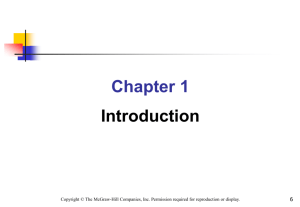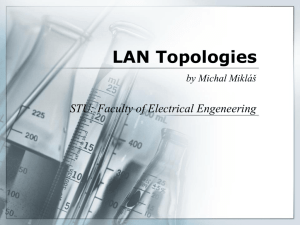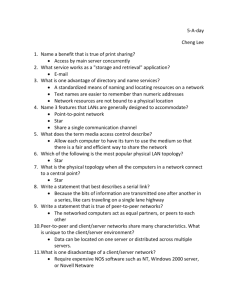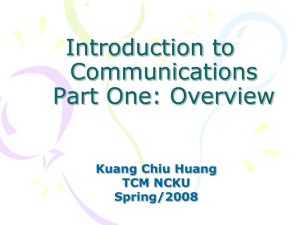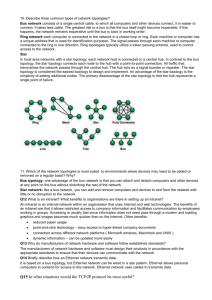Categories of Networks
advertisement
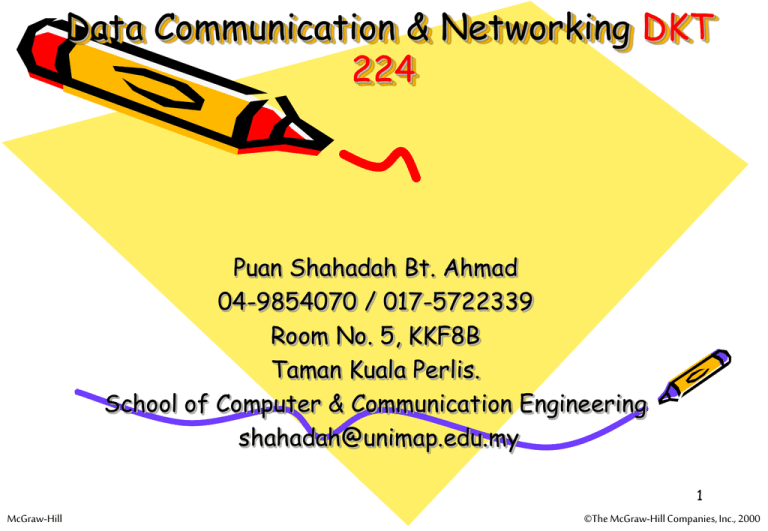
Data Communication & Networking DKT 224 Puan Shahadah Bt. Ahmad 04-9854070 / 017-5722339 Room No. 5, KKF8B Taman Kuala Perlis. School of Computer & Communication Engineering shahadah@unimap.edu.my 1 McGraw-Hill ©The McGraw-Hill Companies, Inc., 2000 Course Outcomes 1. 2. 3. 4. Students will be able to understand the theory and basic of data communication and network. Able to identify network connection concept and protocol used Students will be familiarized with the data communication network equipments and instruments to analyze network protocol and perform some troubleshooting Students be exposed to network architecture and new technologies in data communication and network. 2 Syllabus Course Contents StudyWee k 1,2 INTRODUCTION Chapter 1 Introduction to data communications - component, data representation and data flow Chapter 2 Introduction to data communication networks , -network criteria, physical structures, network models, categories of networks and Internet work. -protocols and standards (4 hours) 3,4,5 PHYSICAL LAYER AND MEDIA (review) Chapter 3,4,5 Data and signals, Digital transmission and analog transmission Chapter 6 ,7 3 Syllabus Study Week 6,7 Course Content DATA LINK LAYER Chapter 10 Error Detection and Correction (4 hours) 9,10 DATA LINK LAYER( cont..) Chapter 11,12 Data link control & Multiple access (4 hours) 4 Syllabus Study Week 11,12 Course Content Chapter 13,14 Wired and wireless LANs (4 hours) 13,14 SECURITY Chapter 30 Cryptography (4 hours) 5 Assessment •Final Exam - 50 % •Course Work – 50 % –Lab Reports/test– 30 % –Test 1 & 2 – 10 % – Group Assignment/Quiz – 8 % –Attendance / tutorials – 2 % 6 McGraw-Hill ©The McGraw-Hill Companies, Inc., 2000 Lab experiment • LAB 1 - Fundamental of Data Communication Technique • LAB 2 - Network protocol analyzer • LAB 3 - Network setup - UTP cable • LAB 4 - Wireless access point configuration • LAB 5 - Network Analysis –measuring Throughput 7 References 1.Behrouz A. Forouzan, Data Communications and Networking, 4th Edition, McGraw Hill, 2007 (TEXT BOOK) 2. William Stalling, Data and Computer Communications ,7th Edition, Prentice Hall, 2005. 3.Wayne Tomasi, Introduction to Data Communications and Networking, Prentice Hall,2004. 8 McGraw-Hill ©The McGraw-Hill Companies, Inc., 2000 Chapter 1 Introduction 9 Copyright © The McGraw-Hill Companies, Inc. Permission required for reproduction or display. 1-1 DATA COMMUNICATIONS The term telecommunication means communication at a distance. The word data refers to information presented in whatever form is agreed upon by the parties creating and using the data. Data communications are the exchange of data between two devices via some form of transmission medium such as a wire cable. Topics discussed in this section: Components Data Representation Data Flow 10 Figure 1.1 Five components of data communication 11 Data Representation • TEXT – unicode (32 bits to represent character)- ASCII • NUMBERS • IMAGES-composed of a matrix of pixel • AUDIO- recording or broadcasting of sound or music. • VIDEO- recording or broadcasting of a • picture or movie 12 Figure 1.2 Data flow (simplex, half-duplex, and full-duplex) 13 1-2 NETWORKS A network is a set of devices (often referred to as nodes) connected by communication links. A node can be a computer, printer, or any other device capable of sending and/or receiving data generated by other nodes on the network. Topics discussed in this section: Distributed Processing Network Criteria Physical Structures Network Models Categories of Networks Interconnection of Networks: Internetwork 14 NETWORKS Set of nodes connected via physical links – 1) Distributing Processing – 2) Sharing Data and centralization – 3) Security and robustness 15 Network Criteria 1) Performance : Transmission and • response times’ throughput and delay. 2) Reliability: How often the networks fail 3) Security: Privacy and integrity of communication Data; recovery from breaches and data loss. 16 Physical Structures: • Types of connections: • 1) Point to Point: (P to P) Dedicated link to be utilized only by end devices. • 2) Multipoint (Multidrop): Many end devices share the link capacity. 17 Figure 1.3 Types of connections: point-to-point and multipoint 18 Physical Topology 19 Figure 1.4 Categories of topology 20 Physical Topology • A) Mesh: • Each device has dedicated point-to-point link to other devices. Fully connected mesh will have n( n-1)/ 2 F.D. links – Where n = number of nodes • Advantages: Fast communication, Robust and Privacy (Security) • Disadvantages: Cabling Space and cost 21 Figure 1.5 A fully connected mesh topology (five devices) 22 Physical Topology (cont..) • B) Star: • Devices are connected Point to Point to a central “Hub” (Controller Exchanger) • Advantages: Less cabling and H/W ports, two hops only. • Disadvantage: Not robust 23 Figure 1.6 A star topology connecting four stations 24 Figure 1.7 A bus topology connecting three stations 25 – C) Bus: • Multipoint link as “backbone” for a network where devices have drop line to tap into the bus Advantage: Less Cabling • Disadvantages: Topology dependent, limit number of nodes on the bus due to signal power loss with distance, not so 26 robust Figure 1.8 A ring topology connecting six stations 27 • C) Ring: Each device connects Point to Point with only two other devices in a left and right neighbors arrangement via a repeater. • Advantages : easy installation, better fault isolation and robustness. • Disadvantages: N/2 hops communication 28 Figure 1.9 A hybrid topology: a star backbone with three bus networks 29 • D) Hybrid: • Pizza “star” inside a “ ring” • Pros: Better robustness, still low cost, Delay is 1 hop (until the star is not with a ring cut, max 2. • Star of busses 30 Categories of Networks: • Local Area Networks (LAN): Few Kilometers Connects devices (Pcs, printers, servers.) within the same room, building, company, and campus. • Topologies most used are bus, ring and star. 31 Figure 1.10 An isolated LAN connecting 12 computers to a hub in a closet 32 Categories of Networks(cont..) • Wide Area Networks (WAN): • span a large geographical area about 100’s – 1000’s of Km • 1) Switched: End users connected via a cloud of switches (subnet). • 2) Point-to Point: Line leased from telephone company/ TV connecting users to the ISP for Internet access. 33 • alternative technologies used include: – – – – circuit switching packet switching frame relay Asynchronous Transfer Mode (ATM 34 Circuit Switching • uses a dedicated communications path established for duration of conversation • comprising a sequence of physical links • with a dedicated logical channel • eg. telephone network 35 Packet Switching • data sent out of sequence • small chunks (packets) of data at a time • packets passed from node to node between source and destination • used for terminal to computer and computer to computer communications 36 Frame Relay • packet switching systems have large overheads to compensate for errors • modern systems are more reliable • errors can be caught in end system • Frame Relay provides higher speeds • with most error control overhead removed 37 Asynchronous Transfer Mode (ATM) • • • • • evolution of frame relay fixed packet (called cell) length with little overhead for error control anything from 10Mbps to Gbps constant data rate using packet switching technique with multiple virtual circuits 38 Figure 1.11 WANs: a switched WAN and a point-to-point WAN 39 Figure 1.12 A heterogeneous network made of four WANs and two LANs 40 Categories of Networks(cont..) • Metropolitan Area Networks: • MAN town/city • High-speed backbone linking multiple LAN’s, DSL, TV cables. 41 1-3 THE INTERNET The Internet has revolutionized many aspects of our daily lives. It has affected the way we do business as well as the way we spend our leisure time. The Internet is a communication system that has brought a wealth of information to our fingertips and organized it for our use. Topics discussed in this section: A Brief History The Internet Today (ISPs) 42 The Internet • Internet evolved from ARPANET – – – – first operational packet network applied to tactical radio & satellite nets also had a need for interoperability led to standardized TCP/IP protocols 43 The Internet: • Huge number of interconnected Networks (100000’s) private organized, e.g.’ government, schools, research facilities, in many countries • Collection of LAN’S, MAN’S and WAN’s. – The internet protocol stack is the TCP/IP – End users use the internet via Internet Service providers (ISPs) which are of the following hierarchies: 44 Figure 1.13 Hierarchical organization of the Internet 45 Internet Elements 46 Internet Architecture 47 Example Configuration 48 1-4 PROTOCOLS AND STANDARDS In this section, we define two widely used terms: protocols and standards. First, we define protocol, which is synonymous with rule. Then we discuss standards, which are agreed-upon rules. Topics discussed in this section: Protocols Standards Standards Organizations Internet Standards 49 What is a protocol? Communications between computers requires very specific unambiguous rules A protocol is a set of rules that governs how two or more communicating parties are to interact Examples Internet Protocol (IP) Transmission Control Protocol (TCP) HyperText Transfer Protocol (HTTP) 50 • Elements: • 1) Syntax: PDU format – 2) Semantics: The meaning of each PDU’s field – 3) Timing: Synchronization of communication when PDU is to be transferred and its data rate. 51 What is a standard? – • A “ standard is set of guidelines” to users and manufactures to ensure interconnectivity. – 1) “Defacto” not approved but widely used (TCP/IP) – 2) “Dejure”: approved by recognized body (IEEE 802.X). 52 Summary • • • • • introduced data communications needs communications model defined data communications overview of networks introduce Internet 53
